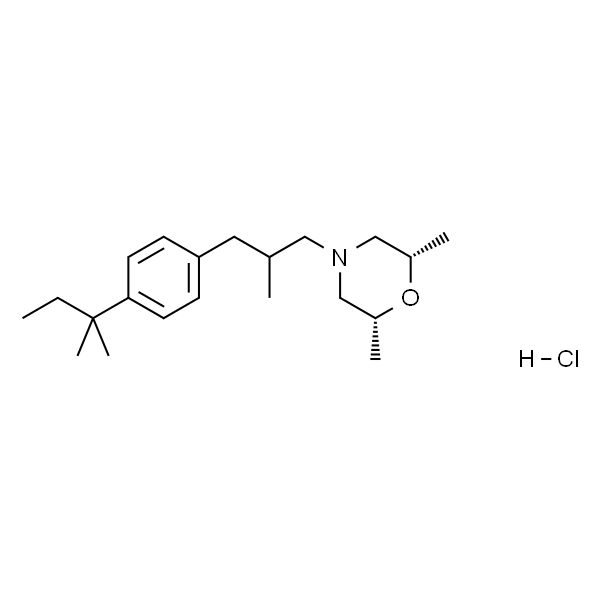| CAS |
78613-38-4 |
| Chinese Name |
盐酸阿莫洛芬 |
| English Name |
Amorolfine Hydrochloride |
| Synonyms |
Ro 14-4767/002 |
| Molecular Formula |
C21H35NO·HCl |
| Molecular Weight |
353.97 |
| Solubility |
Soluble in Water/DMSO ≥1mg/mL |
| Purity |
≥98% |
| Appearance |
White to off-white Solid |
| Storage |
Powder:2-8℃,2 years;Insolvent(Mother Liquid):-20℃,6 months;-80℃,1 year |
| EC |
EINECS 689-236-9 |
| MDL |
MFCD00903738 |
| SMILES |
C[C@@H]1O[C@H](C)CN(CC(C)CC2=CC=C(C(C)(C)CC)C=C2)C1.Cl |
| InChIKey |
XZKWIPVTHGWDCF-KUZYQSSXSA-N |
| InChI |
InChI=1S/C21H35NO.ClH/c1-7-21(5,6)20-10-8-19(9-11-20)12-16(2)13-22-14-17(3)23-18(4)15-22;/h8-11,16-18H,7,12-15H2,1-6H3;1H/t16?,17-,18+; |
| PubChem CID |
54259 |
| Target Point |
Fungal |
| Passage |
Anti-infection |
| Background |
Amorolfine Hydrochloride is an antifungal compound. |
| Biological Activity |
Amorolfine (Ro 14-4767/002) hydrochloride is a potent anti-fungal agent. Amorolfine hydrochloride inhibits ergosterol biosynthesis. Amorolfine hydrochloride has the potential for the research of Neoscytalidium dimidiatum onychomycosis[1][2]. |
| In Vitro |
Amorolfine hydrochloride acts primarily by inhibiting ergosterol biosynthesis, a component of fungal cell membrane, and possesses both fungistatic and fungicidal activity[1].Amorolfine hydrochloride (0-128 mg/l) (2-7 days) shows anti-fungal activity for Dermatophyte fungi, Filamentous fungi, Pathogenic yeasts, Dimorphic fungi, Dematiaceous fungi[1].Amorolfine hydrochloride shows anti-fungal activity with 90% killing corresponding concentrations of 3, 3, 10 and 100 mg/L for Trichophyton mentagrophytes, C. albicans, Histoplasma capsulatum, Cryptococcus neoformans, respectively[1]. |
| In Vivo |
Amorolfine hydrochloride (0.01%-1%; Intravaginal application; twice daily for 3 days) shows anti-fungal activity in rats with vaginal candidiasis[1]. |
| Data Literature Source |
[1]. Haria M,et al. Amorolfine. A review of its pharmacological properties and therapeutic potential in the treatment of onychomycosis and other superficial fungal infections. Drugs. 1995 Jan;49(1):103-20.
[2]. Bunyaratavej S,et al. Efficacy of 5% amorolfine nail lacquer in Neoscytalidium dimidiatum onychomycosis. J Dermatolog Treat. 2016 Aug;27(4):359-63. |
| Unit |
Bottle |
| Specification |
50mg 10mM*1mL in Water 100mg 200mg |


 English
English
 中文
中文

 Manual Download
Manual Download

